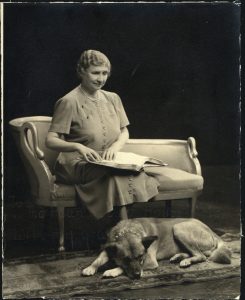
Helen Keller in 1947 with her second Akita, Kenzan-Go, a gift from the Japanese government.
(Source: Archives of New Zealand)
“Is your dog a Husky mix? Part Chow?” If you own an Akita, you’ve probably heard questions like these. Many people are familiar with the Akita’s cousins – Huskies, Malamutes, Chow-Chows, Norwegian Elkhounds and others – but few know much about the breed that is Japan’s natural monument. The Akita is a member of the Spitz group, which includes many northern snow breeds.
The noble Akita goes back at least 1,000 years as a human companion and helper. Originally, the Akita’s regional ancestors, called Matagiinu, were medium-sized landrace dogs bred to serve as hunting companions. All of their original “wolf” skills, from finding prey all the way through killing it, were considered desirable traits in those days, because hunting was done with bow and arrow, and the prey large and fierce. The Akita Matagiinu were prized because they were fearless in their tracking and holding of bear and wild boar, and they were extremely loyal to their owners. These traits are still true today. What today’s pet owners sometimes call “stubbornness” was then viewed as persistence and fearlessness – both very important qualities.
During Japan’s medieval era, these regional hunting dogs remained largely unchanged in character, but soon after, during the Tokugawa Shogun era, their job changed. While rural villagers in the Tōhoku area still hunted with their Matagiinu, the nobility and upper classes began breeding their dogs larger to be more imposing as guardians of their people and property. The original traits of loyalty and fearlessness were again invaluable, because to do these jobs, the dogs had to think for themselves. Where other breeds were needed to perform specific tasks (point, flush, retrieve), the Akita’s ancestors were expected to be persistent in their pursuit of prey and self-directed in guarding their territory. Another function that the local dogs served was in dogfighting. For approximately 300 years, the Akita hunting dogs and the Akita fighting dogs co-existed with the fighting dogs being mixed with an assortment of western breeds for an even larger size during the Meiji era (1868-1912) and Taisho era (1912-1926).
In 1927, the Akitainu Hozonkai (AKIHO) was established as the world’s first Akita preservation society. In 1931, the Akitainu was designated a natural monument. In 1932, a newspaper published a story about Hachiko and his loyalty to his owner Professor Ueno. The story became famous worldwide. In fact, while on a tour of Japan in 1937, Helen Keller expressed her affection for Hachiko’s story and was given an Akita as a gift from the Japanese government. Keller’s puppy Kamikaze was the first Akita to be brought to the U.S. and his brother Kenzan was the second.
During World War II, the Akita fell upon hard times as many civilians became unable to care for their pets, and the Japanese government confiscated dogs not engaged in military operations. Many dogs were killed for their coats. Luckily, the breed was saved by a few dedicated owners, who hid their Akita in the safety of rural Tohoku mountain towns at their own personal risk. According to Japanese sources, a total of only 18 purebred Akita remained. After the war, Japanese breeders began a second phase of restoring the breed. Some lines were imported to the United States and formed the foundation of the American Akita while the Japanese breeders concentrated on other lines to restore the breed as one of the Nihonken (native Japanese breeds).
There are now two recognized breeds – the Japanese Akitainu and the American Akita though both have the same origins from the landrace Matagiinu. It’s no wonder that today’s Akitas are just as strong, confident and loyal to their families as the ancestral litters, a millennium ago.
The breeds have become increasingly popular, though often misunderstood. Thus, it is important to remember that strong will and loyalty continue to characterize both noble breeds today, because the genes for these traits have been maintained and valued, generation after generation.

